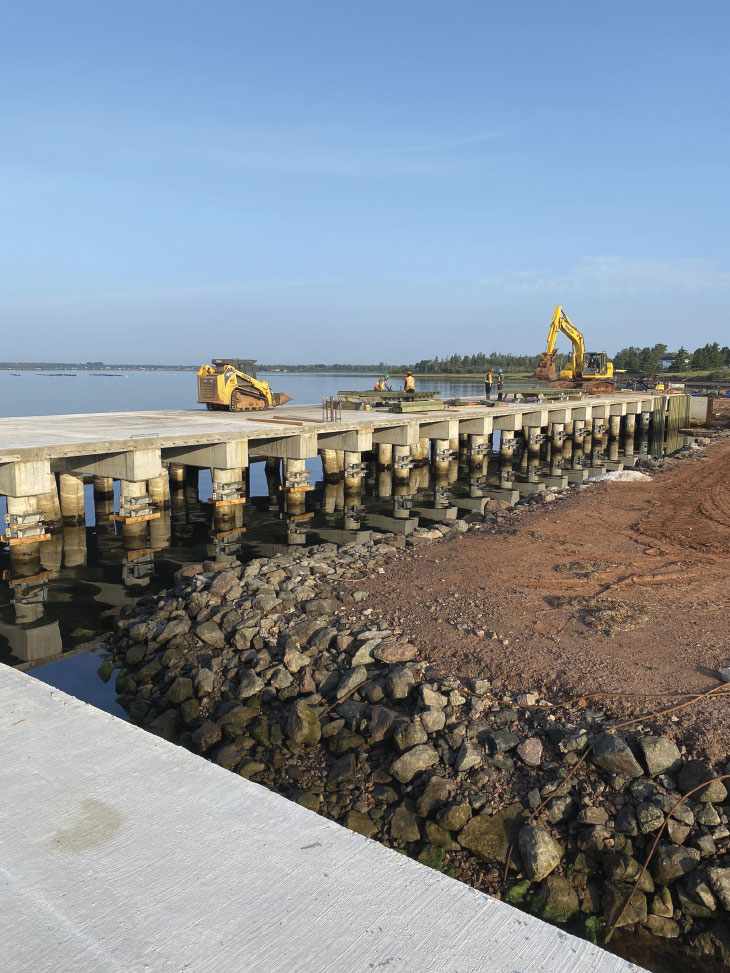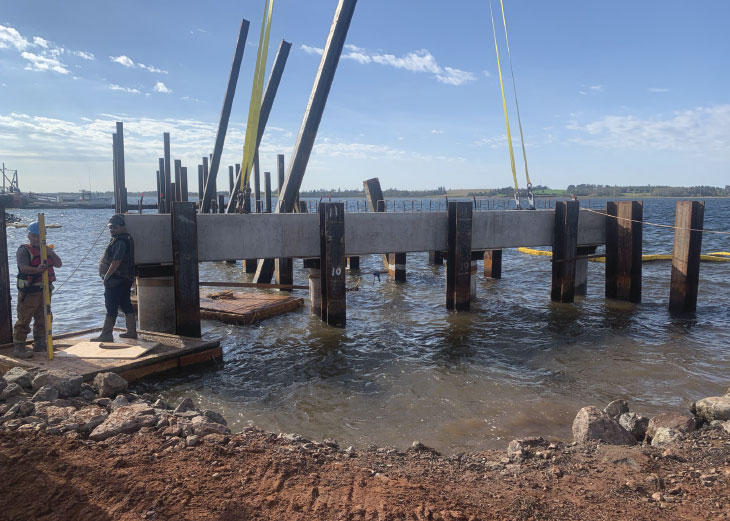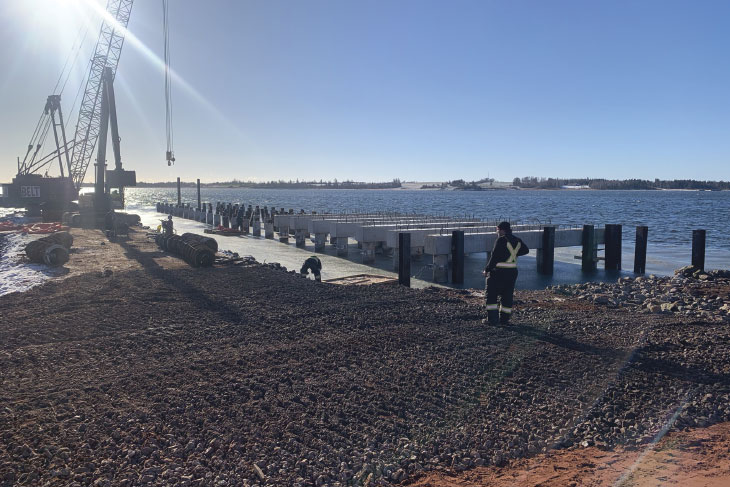
Located along the northern coast of Prince Edward Island, Lennox Island First Nation (LIFN) is a Mi’kmaw community with a long history of traditional and commercial fishing operations, which remains the primary economic driver of the community.
With an increase in fishing activity in LIFN and a lack of spots to properly dock boats, it was determined more than a decade ago that there was a need to strengthen and expand the more than 25-year-old infrastructure at the community’s wharf facility. However, the need became more acute following hurricane Fiona in September 2022, which damaged the existing infrastructure.
The Lennox Island Wharf Expansion project was tendered in late 2022 to provide increased structural capacity, as well as offer increased climate resiliency for LIFN. Work on the project began in March 2023 and was substantially completed in March.
“Prior to the new wharf, the existing [one] could not effectively accommodate the number of fishers, so there was certainly a need for more space,” said Michael Bingley, construction project manager at Noye and Noye Limited. “The existing wharf’s elevation was vulnerable to the region’s rising waters and was being flooded more frequently. As such, it was decided to raise the existing wharf elevation to match the elevation of the new wharf. During the raising operation, a number of damaged tie rods were replaced and lightweight fill was added to adjust the deck elevation.”

“To offset the loss of habitat caused by the new wharf footprint, we supplied and placed approximately 7,000 concrete lobster reefs in a designated nearby area of water to improve the habitat of lobster spawn.”
Michael Bingley, Noye and Noye Limited
Specializing in bridge and wharf construction, Noye and Noye Limited is a fourth-generation, family-owned business founded more than 40 years ago. Today the company is one of the largest contractors on P.E.I. and – in addition to bridge and wharf construction – offers trucking, landscaping, pile driving and shore protection services.
The scope of the project included the following deliverables:
- The construction of a new sheet piling and armour stone berm boat slip adjacent to the existing sheet pile wharf structure.
- The construction of a new finger pier, complete with concrete deck, cap beams on steel piles and timber sheathing.
- Harbour dredging (with storage and drying of dredge material for re-use to construct a new parking area), including construction and removal of temporary surcharging of the parking area.
- The supply and installation of mooring cleats, wheel guard, wheel guard blocking, fenders, ladders and associated hardware.
- The supply and installation of all armour stone, granular material and hot mix asphalt pavement.
- The supply and installation of water, sanitary and storm drainage systems, and the re-location of an existing building.
- The construction of a new washroom and electrical building and electrical system upgrades.
- A relocation of the existing fuel tank, complete with new concrete slab, new precast concrete containment system and all necessary electrical and/or mechanical hook-ups.
- The supply and installation of a new winch system.
As Noye and Noye is based in Tyne Valley, P.E.I., and only minutes away from LIFN, the company was the logical choice in terms of proximity, capacity and resources to successfully bring this project to fruition, and so its low bid was accepted.

“We could mobilize to site at greatly reduced cost compared to an off-island company, providing a better value to [LIFN],” said Bingley. “We also have long-standing working relationships with all parties involved in this project, which translated into a seamless partnership and effective communication throughout the project’s life cycle.”
The piling scope
Noye and Noye used a Delmag D30-32 single action diesel pile hammer equipped with a 150-tonne truck crane to complete the piling scope for the project, which included 241 steel HP310x174 piles of lengths ranging from 12 to 33 metres. The company also used custom fabricated steel templates to hold the piles in place during pile driving, occasionally using its MKT 9B3 air hammer during initial pile drive as required for the accuracy of pile placement.
All piles were driven into the bedrock using the diesel impact hammer, until a certain number of blows from the hammer to move the pile by 25 millimetres – the refusal criteria – was reached. Pile Driving Analyzer testing conducted during the pile drive operation confirmed that the energy output of the hammer was sufficient and to provide an indication of the pile’s capacity.

“We proposed significantly modifying the design from entirely cast-in-place concrete to a hybrid design with precast pile caps and placing precast deck panels that constitute the lower half of the concrete deck,” said Bingley. “This change improved the schedule and overall quality as we could cure the pile cap beams and deck panels in a controlled environment over the winter.”
The company built a large 7,000-tonne rock berm beside the structure to facilitate crane access and then reclaimed the rock after the crane operations were completed. Noye and Noye also implemented a water quality monitoring program and stayed on top of environmental controls. Because of the nearby oyster operations, dredging the new wharf bullpen required the utmost care to mitigate sediment in the water as much as possible. As such, the company placed two silt booms along the perimeter and sectioned off the entire area.
“In addition, to offset the loss of habitat caused by the new wharf footprint, we supplied and placed approximately 7,000 concrete lobster reefs in a designated nearby area of water to improve the habitat of lobster spawn,” said Bingley.
A challenging project
The project site presented some challenging soil conditions as the company encountered bedrock at a shallower depth than anticipated at several locations, requiring a significant amount of time to break up the bedrock within the bullpen and provide sufficient dredge depth for fishing boats. In addition, Noye and Noye ran into an issue along a section of the Berlin Wall, where the bedrock was notably higher in elevation than expected and had to mechanically break it apart with heavy machinery to seat the wall panels between the piles.

Another challenge was related to the amount of dredge material on site, which exceeded the estimated amount, as well as what to do with the excess material given the significant cost to hauling and disposing it off Lennox Island. “After testing this material for contaminants, we proposed using it to construct a parking lot to the south of the new wharf, which turned out very well at a significant savings to the owner,” said Bingley.
To ensure a safe worksite, Noye and Noye retained Kimber and Tucker as a third party to conduct safety inspections on a continual basis and held weekly “toolbox talks” with the foreman and crews to review safe work practices, emergency responses, muster points and safety concerns. “We also held joint health and safety committee meetings to discuss and implement ways to improve our safety measures, wherever possible,” said Bingley.
Collaboration pays dividends
The wharf expansion project has brought a wide range of stakeholders to the table, including LIFN (owner), Delcom (owner’s rep), Investing in Canada Infrastructure Program, Atlantic Canada Opportunities Agency and Indigenous Services Canada (funding partners) and WSP Inc. (consultant). In addition, Noye and Noye has also partnered with many suppliers and subcontractors, including electricians, divers and paving contractors, which required a high level of collaboration from all parties and bi-weekly progress meetings to discuss all aspects of the project.
One lesson learned through this collaboration was how important it is to continually search for solutions that can provide value to all stakeholders.
“For example, the original design specified running electrical conduit underneath the wharf, which went down and up every pile cap beam – we proposed running the conduit on top of the timber wale, which resulted in less conduit and cable being used, less voltage drop and a faster, easier install that shaved days off the schedule and provided cost savings to benefit everyone,” said Bingley. “The response was overwhelmingly positive, and everyone involved was very happy with the end result, not to mention having the new wharf open and ready in time for the 2025 fishing season.”